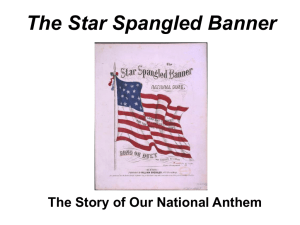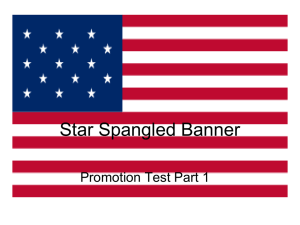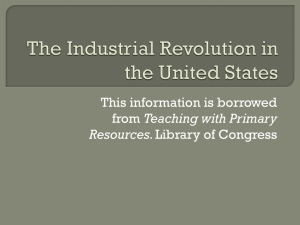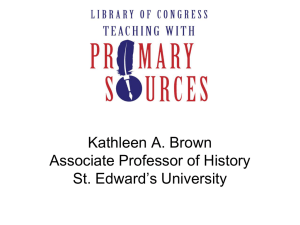The Story of the Star Spangled Banner - TPS
advertisement
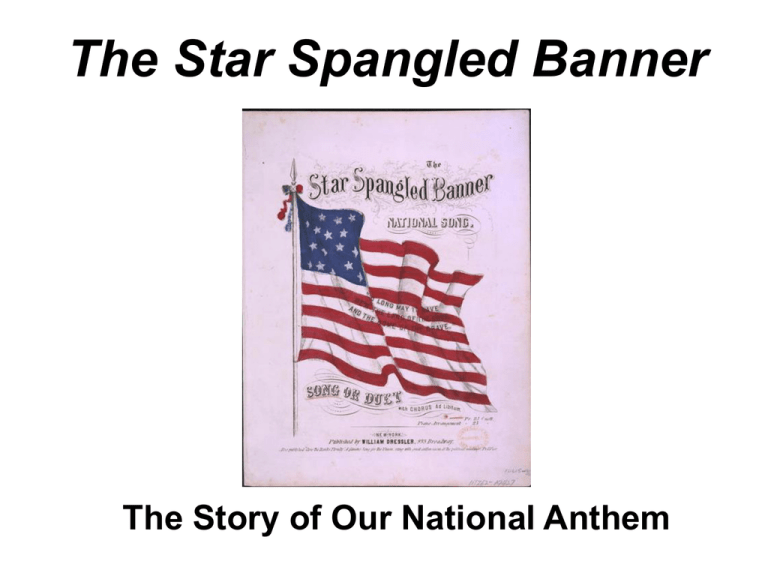
The Star Spangled Banner The Story of Our National Anthem Francis Scott Key & The Star Spangled Banner Hello, I’m Francis Scott Key. I have a story to tell you about a great American flag. The flag flew strong while British and American soldiers fought a battle during the War of 1812. After, I wrote a song about the flag that later became our national anthem. American Ships Captured For 4 years, ships from England and France were capturing American ships and forcing captured American sailors to serve in the British Royal Navy. America Declares War June 18, 1812 In 1812, United States President James Madison declared war against King George III, king of Great Britain and Ireland. President James Madison King George III Baltimore, Maryland Baltimore, Maryland is the site of Fort McHenry. This fort was used to protect America during the War of 1812. Fort McHenry and Its Flag In 1813, Major George Armistead decided Fort McHenry needed a very big flag so that the British could see it from far away. Mary Pickersgill Makes Giant Flag for Fort McHenry The flag was 30 feet wide and 42 feet long and weighed over 200 pounds! Washington D.C. Is Burning In 1814, President Madison had to leave Washington D.C. when British troops burned many buildings, including the White House, the U.S. Capitol, and the Library of Congress. Tornado Saves Washington, D.C. Luckily, a tornado put out the fires set by the British and wiped out many British soldiers. The Battle of Fort McHenry I was working as a lawyer when President Madison asked me to help free a doctor who was being held prisoner on a British ship. The British let the doctor go but attacked Fort McHenry at 6:30 a.m. on September 13, 1814. The Battle and the Song The British attacked Fort McHenry for one whole day, but didn’t capture it so they gave up the fight. A few months later, the war ended. Seeing the battle made me think of a song about the big flag at Fort McHenry. I Write the Song Quickly After I returned home, I quickly finished my song, which had 4 verses. It was printed just a few days after the battle at Fort McHenry! I Have a Hit Song! People really liked my song; it became a big hit! My Song, the United States National Anthem More than 100 years later, The Star Spangled Banner became the official song of the United States. Do You Know the Words to My Song? My song has 4 verses, but only the first verse is sung today. Let’s learn the words! Credits COURTESY OF: This presentation was developed by the American Memory Initiative of Barat Education Foundation through the support of the United States Congress and The Library of Congress. SPECIAL THANKS: This presentation was designed and created by the individuals listed below. Wendy Wiegers Julie Schaul Justine Braskich Marita Decker John K. Schaul 2005 Barat Teacher Scholar Project Development Director Community Relations Manager Program Director Narrator Citations (1) Slide 1: Dressler, William, publisher. “The Star spangled banner : national song / Stackpole, sc.” Circa 1861. Library of Congress Prints and Photographs Division. http://hdl.loc.gov/loc.pnp/cph.3g02895 (05/10). Slide 2: Moran, Percy. "The Star Spangled Banner." Circa 1913. Library of Congress Prints and Photographs Division. http://hdl.loc.gov/loc.pnp/cph.3g06200 (05/10). Slide 3: Detroit Publishing Company. "U.S.S. Constitution and H.M.S. Java." Photograph of a painting dated Dec. 23, 1812, created between 1900 and 1920. Detroit Publishing Company Photograph Collection. http://hdl.loc.gov/loc.pnp/det.4a26410 (05/10). Slide 4: "James Madison." Library of Congress Prints and Photographs Division. http://loc.gov/pictures/item/2003679975/ (05/10). "His most sacred majesty George III, King of Great Britain." Library of Congress Prints and Photographs Division. http://loc.gov/pictures/resource/cph.3a10456 (05/10). Slide 5: Folie, A.P. "Plan of the town of Baltimore and it's [sic] environs." 1792. Library of Congress Geography and Map Division. http://hdl.loc.gov/loc.gmd/g3844b.ct000792 (05/10). Citations (2) Slide 6: Wiegers, Dave. “George Armistead.” 2005. Bufford, J.H. from a drawing by Corporal E.S. Lloyd, of Dodd's Carvers. "Fort McHenry, Baltimore, Md., 1861, occupied by the 3rd Battalion of Rifles, M.V.M." Circa 1861. Library of Congress Prints and Photographs Division. http://www.loc.gov/pictures/item/93510713 (05/10). Slide 7: “Mary Young Pickersgill (1776-1857).” Circa 1846. [MSA SC 3520-12457] Accessed from the Maryland State Archives (05/10). http://www.mdarchives.state.md.us/msa/speccol/sc3500/sc3520/012400/012457/html/msa124 57.html “The Star-Spangled Banner at the Boston Navy Yard.” 1873. Accessed (10/05), with permission from the American Antiquarian Society, from the Smithsonian National Museum of American History website (http://www.americanhistory.si.edu/ssb/6_thestory/gfx/6a3b_main_l.gif). Slide 8: Fores, S.W., publisher. “The fall of Washington--or Maddy in full flight.” 1814. British Cartoon Collection, Library of Congress Prints and Photographs Division. http://hdl.loc.gov/loc.pnp/cph.3g03115 (05/10). Slide 9: Thompson, G., publisher. “The taking of the city of Washington in America.” 1814 Oct. 14. Library of Congress Prints and Photographs Division. http://hdl.loc.gov/loc.pnp/cph.3g04555 (05/10). Citations (3) Slide 10: “Francis Scott Key, 1780-1843.” Library of Congress Prints and Photographs Division. http://hdl.loc.gov/loc.pnp/cph.3b00995 (05/10). Slide 11: Bower, J. “A View of the Bombardment of Fort McHenry.” 1816. http://commons.wikimedia.org/wiki/File:Ft._Henry_bombardement_1815.jpg (05/10). Slide 12: Key, Francis Scott. “The Star-Spangled Banner.” Washington, D.C., 1840 Holograph Music Division. http://www.loc.gov/exhibits/treasures/images/uc05112x.jpg Key, Francis Scott. “Defence of Fort McHenry.” 1814. http://en.wikipedia.org/wiki/Defence_of _Fort_M’Henry (05/10) Slide 13: Key, Francis Scott (1779-1843). "The Star-Spangled Banner.” Baltimore: Thomas Carr, 1814. Printed sheet music. Music Division Purchase, 1941. http://www.loc.gov/exhibits/treasures/images/vc29.1.jpg (05/10). Slide 14: Horydczak, Theodor. “Charlotte Hall Military Academy. Marching with flags and rifles.” Circa 1920-1950. Theodor Horydczak Collection (Library of Congress). http://hdl.loc.gov/loc.pnp/thc.5a36462 (05/10). Slide 15: De Marsan, H., publisher. “The star-spangled banner.” America Singing: NineteenthCentury Song Sheets, Rare Book and Special Collections Division, Library of Congress. [sb40475a] http://memory.loc.gov/cgibin/query/r?ammem/amss:@field(DOCID+@lit(sb40475a)) (05/10).
